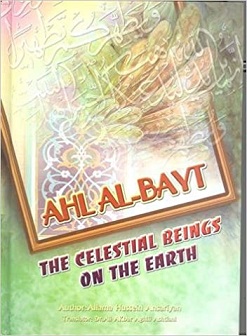Ahl al-Bayt:The Celestial Beings on the Earth
The book Ahl al-Bayt: The Celestial Beings on the Earth gives understanding of the purified household of the Holy Prophet.
 | |
| Author | Hossein Ansarian |
|---|---|
| Translator | Ali Akbar Aghili Ashtiani |
| Language | English |
| Published | 2007 |
| Publisher | Ansariyan Publications |
| Pages | 241 |
About the authorEdit
Hossein Ansarian born on 9 November 1944 in Khansar, Isfahan, Iran is an Iranian Shia cleric. When Hossein was three years old, they went to Tehran and lived in Khorasan district where Ali Akbar Borhan, Shia scholar, established Borhan school and Hossein participated in his classes. After high school, he decided to go to Seminary. In 1962, he went to Qom Seminary and then continued his education in Qom and Tehran Seminary.
About the bookEdit
This book written by Hossein Ansarian and translated into English by Ali Akbar Aghili Ashtiani was published in Ansariyan Publications (January 1, 2007). It has 241 pages, and describes whatever it means to be a follower of the Ahlul Bayt, visiting their shrines, mourning over them and thanking ALLAH for the blessings of Ahlul Bayt. The Persian version of this book has reached its seventh edition in Iran.
Abstract of chaptersEdit
Chapter 1: Character of Ahl Al-BaytEdit
This chapter examines the necessity of knowing the Ahl al-Bayt that is recommended by the Holy Prophet to follow them. It has been ordered that Getting to know the Ahl al-Bayt leads to getting to know Allah, and the Holy Quran as well as it develops intuition. The writer believes that Ahl al-Bayt are not only the path but they are Allah's rope extended from the heavens to the earth and holding fast by the covenant of Allah can lead us to the peak of perfection.
Chapter 2: Ahl Al-Bayt in Divine BooksEdit
This chapter starts with this fact that the Holy Quran gives such an excellent dignity to the Prophet considering the allegiance to him to beequal to allegiance to Allah and obeying the Holy Prophet just like obeying Allah. This is a good reason, which proves the superiority of the Holy Prophet over all other creatures in the universe. The chapter goes on with the fact that the Holy Quran states that the signs and features of the Holy Prophet have been mentioned in the former scriptures especially the Torah and the Gospel. Knowing the Prophet by verses in the Torah and the Gospel, Jews and Christians were waiting for his advent before his ordainment so as to overcome their enemies under his rule and attain spirituality through following him.
Chapter 3: Ahl Al-Bayt from The Viewpoint of MysticsEdit
The writer declares that there are few philosophers, theologians and narrator of traditions, historians, jurisprudents and men of letters who have not said or written something about Ahl al-Bayt, their dignity and their personality. Yet, mystics have spoken and written more than the others, for they have probed more into various dimensions of human beings and into the features, virtues and station of Ahl al-Bayt. So this chapter is devoted to their speech, viewpoints and description, and what is mentioned here is only an abstract of what the mystics have said about Ahl al-Bayt.
Then the author brings this chapter to conclusion with a poem by Ibn Arabi as quoted by Sulayman ibn Ibrahim Qunduzi:
Find no peer for Ahlal-Bayt
For they are people of witness
Enmity with them is a big loss
Love for them is a great prayer
"Page 120"
Chapter 4: The Culture of Ahl Al-BaytEdit
In this chapter, the author draws a corner of the humanizing, noble and irreplaceable culture of Ahl al-Bayt. First, a glimpse of the morals of those holy people and then a manifestation of characteristics in their enlightened lives will be examined.
Chapter 5: Followers of Ahl Al-BaytEdit
The Ahl al-Bayt have enumerated certain features and attributes for themselves in various narrations, and according to them, anyone who cultivates these attributes in himself/herself and tries his/her best to keep his/her existence away from vices and impurity is considered a true Shiite.
Chapter 6: ConclusionEdit
In this chapter the author concludes that a perfect recognition of the Ahl al-Bayt is beyond human capacity and although many many books and dissertations have been written on them; yet, there are still many things that have not yet been written or said. He from narrations related by Ahl al- Bayt, infers that getting to know Ahl al-Bayt has many stages.